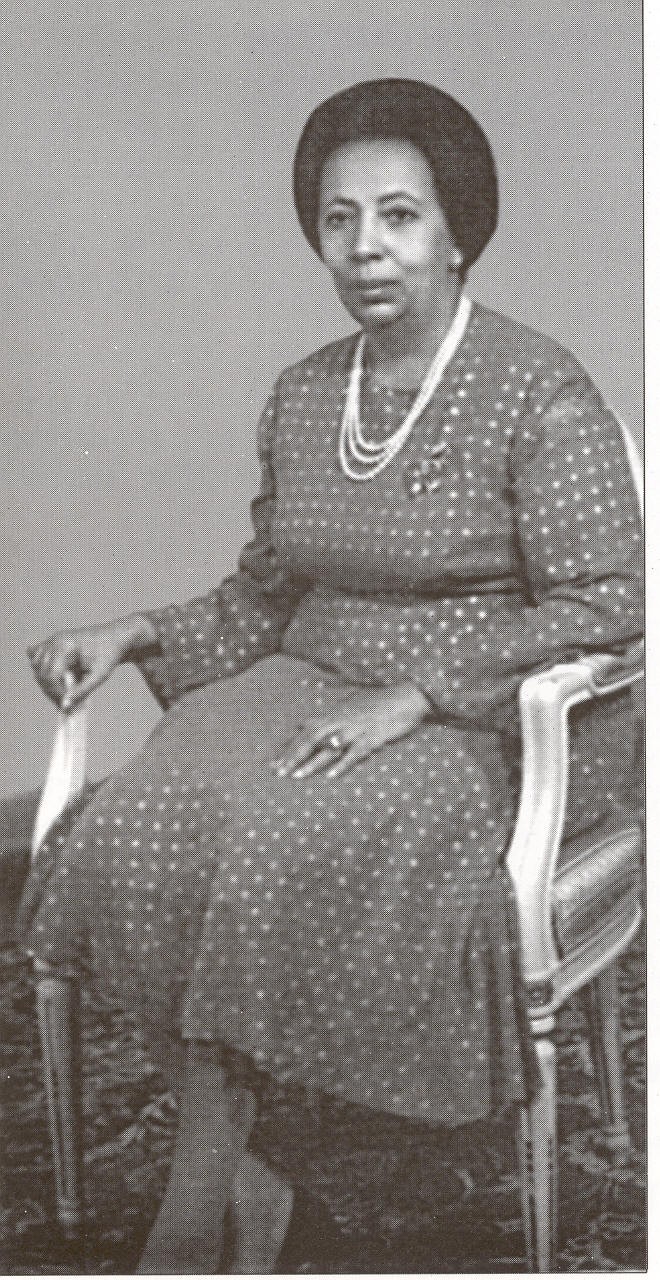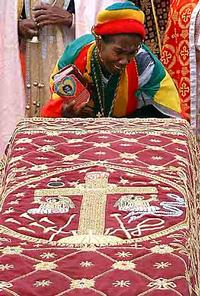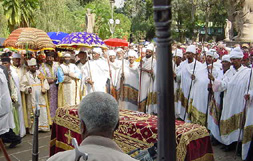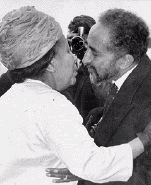Her Imperial Highness shown greeting her father the Emperor
It is with deep regret that we at the Imperial Ethiopia Homepages report that Her Imperial Highness, Princess Tenagnework Haile Selassie of Ethiopia has died on April 6th, 2003. Her Imperial Highness was 90 years old. She was buried at Holy Trinity Cathedral in the Imperial family vault on April 13th, 2003, in a 5 hour funeral presided over by Abune Paulos, Patriarch of Ethiopia, and attended by thousands of mourners including most of the Imperial family and the old Ethiopian Nobility.

Princess Tenagnework (also spelled Tenagne Work) was born in 1912 in the city of Harar, to her parents, Dejazmatch Tafari Makonnen, then governor of Harrarge Province, and Woizero Menen Asfaw his wife. She was the first child of their marriage(Both had children from previous marriages). In 1917, soon after the birth of her younger brother Prince Asfaw Wossen, her father became the Regent and Heir-Apparent of the Ethiopian throne as Ras Tafari Makonnen, Crown Prince of Ethiopia. Subsequently, more children were born into the family. By the time Ras Tafari ascended the Throne of Solomon as Emperor Haile Selassie in 1930, he had three more children. They were Princesses Tsehai and Zenebework, and Prince Makonnen, Duke of Harrar. A year after their coronation, the Emperor and Empress Menen had their last child, Prince Sahle Selassie.

At a young age, Her Imperial Highness Princess Tenagnework was married to Ras Desta Damtew. Ras Desta was a member of the prominent aristocratic Addisge clan, and was given the Province of Sidamo as his governorate. Ras Desta and Princess Tenagnework would become the parents of two sons, Princes Amha and Iskinder Desta (later Rear Admiral), and four daughters, Princesses Aida, Seble, Sophia and Hirut. Ras Desta Damtew was appointed Governor-General, first of Kaffa and Limo, and then of Sidamo. In 1935, Fascist Italy invaded Ethiopia, and the Imperial family were forced to flee. Ras Desta however remained behind to command the Imperial forces fighting in the south of the country. After battling valiantly, Ras Desta was captured and summarily executed by the fascist forces. It would be the first of many tragedies and hardships that would be visited upon her in her long life.

Princess Tenagnework learned of her widowhood while living in exile in Bath England, with her parents, siblings and children. Deeply grieved, she however continued to support her parents in their constant mission to keep attention on the plight of occupied Ethiopia. The Emperor had purchased Fairfield House n Bath, and the family lived here in much reduced circumstances. Money was in very short supply, and the Princess shared in her family's impoverished circumstances. While in exile, she gave birth to Emebet Tsige Mariam (Mary) during a brief union with Ato Abebe Retta, who later served in ambassadorial and other roles in the post-war Imperial government, and would eventually become president of the Imperial Senate after their separation. In 1941, with British assistance, Emperor Haile Selassie was restored to his throne, and Princess Tenagnework and her children returned to Ethiopia. Unfortunately, the Princess would be visited with another tragedy when her elder son, Amha Desta, died shortly before the family returned to Ethiopia. Triumph was thus tempered with tragedy in the life of the Princess. Princess Tenagnework would eventually marry Betwoded (later Ras) Andargatchew Messai, who had formerly served as "Afe-Mesfin" and representative for the underage Prince Makonnen in his Duchy of Harrar. They were married at the Miskea Hazunan Medhane Alem Church (Church of the Savior of the World, Consoler of the Bereaved)in September 1944. Bitwoded Andargatchew was then appointed Governor-General of Beghemidir and Simien Province, and the couple were based in Gondar. During the years following the restoration of the Emperor and the victory over the Italians, a campaign was undertaken to re-unite the former Italian colony of Eritrea with her motherland Ethiopia from whom Italy had snatched that territory late in the 1800's. However, both Eritrean supporters of Union with Ethiopia and those for Independence for Eritrea were numerous.
Therefore a lengthy investigative process was launched by the allied victors of World War II, and then carried on by the United Nations. Finally, after years of negotiations and widespread fact finding on the ground, in a compromise, it was decided that Eritrea would be federated to the Ethiopian Empire under the sovreignity of the Ethiopian Crown. This was done in September, 1951. The Ethiopian Parliament would serve as the Federal Parliament, and Eritrea would have it's own seperate parliament and constitution under the Ethiopian Crown for local issues. The Emperor would be represented in Eritrea by a representative, or vice-roy. The first to fill this post were Betwoded Andargatchew Messai and Princess Tenagnework. After serving for several years in this capacity in Asmara, they returned to Addis Ababa and Bitwoded Andargatchew took up many other further posts in government. He was elevated to the title of Ras, served as Minister of the Interior, and was made an Imperial Senator and a Crown Councilor. Princess Tenagnework and Ras Andargatchew Messai were the parents of a daughter, Mentewab Andargatchew, who died in childhood. Ras Andargatchew had three daughters previous to his marriage to the Princess, who were raised by her.

 Her Imperial Highness Princess Tenagnework Haile Selassie
Her Imperial Highness Princess Tenagnework Haile Selassie
Princess Tenagnework was active in charitable causes in Ethiopia. She worked a great deal with womens organizations, and in womens development issues. She was also the founder of the Sebeta School and Center for the Blind. Additionaly, Her Imperial Highness out of her own private funds, built several public schools for the general public. Among them are schools at Asebot, Wondo Guenet, Kuyera, Gefersa, Sidamo, and many other localities. She also funded special training centers for the physically handicaped at Magdala in Wollo , and Kuyera in Arusi. Her Imperial Highness also funded the building of several churches, and the renovations of others. She also paid for the publication of several religious books, and sponsored several students who studied domestically and also some who went abroad for higher education who would otherwise have been unable to do so. Princess Tenagnework turned over her sizable estate at Ginde Beret to be used as a center for those affected by Leporsy. Her Imperial Highness also donated her large vegitable and animal farm, and tree nursery at Gefersa to the Cheshire Home Charitable Organization. Princess Tenagnework also donated the extensive piece of land on which the now famous Fistula Hospital (one of the few in Africa) established by Dr. Hamlin was built. Princess Tenagnework also established the first old age home for impoverished elderly people with no one to care for them. Also, following the death of her sister H.I.H. Princess Tsehai in 1941, Princess Tenagnework took over the Presidency of the Ethiopian Womens Charitable Works Association in her late sisters place. She thus played a major role in the many works of this organization which she headed until it was dissolved by the Dergue regime in 1974.

 Her Imperial HighnessDuring the Appex of her Influence in the Pre-Revolutionary Period
Her Imperial HighnessDuring the Appex of her Influence in the Pre-Revolutionary Period
After the death of Her Imperial Majesty Empress Menen in 1961, Princess Tenagnework became the most visible and foremost woman at the Imperial court. The Princess was always very close to her father, but now she played an ever increasing advisory role. The princess was one of the few people who was able to freely offer critisism of official policy to the Emperor, and was often a conduit of various points of view to the Emperor when those offering opinions were too intimidated by the Emperor to offer them themselves. The princess was often described as the child most like her father in temperment and character. A strong personality with conservative views, she was widely regarded as being a guardian of the institution of the monarchy, and was concerned that it be upheld in an era of rapid and often unpredictable change. She was percieved as being a leader of the traditionalist element within the nobility that was very wary of demands for constitutional reform and land reform policies, unlike her younger brother the Crown Prince. With the outbreak of the revolution that would topple the monarchy in 1974, Princess Tenagnework, more than anyother figure in government or the Imperial family, besides the Emperor himself, became the victim of vicious attacks. The marxist military junta known as the Dergue launched a campaign of vilification of the princess that can only be compaired to the vicious propoganda campaigns against Queen Marie Antoinette and Empress Alexandra of Russia during the French and Russian revolutions, but with even less justification. She was labled a heartless and vicious hardline reactionary. The Dergue blamed her for virtually all the ills and wrongs commited in the Empire. Even elements of the Emperor's own government, when questioned by the Dergue, during the early period of their imprisonment, about their various policies found it convenient to blame the princess as having constantly undermined them to further a reactionary agenda. They may have hoped that blaming the princess would divert the wrath of the Dergue away from them. It did not.

Princess Tenagnework and the rest of the Imperial family of Ethiopia were arrested on September 11, 1974, the day before Emperor Haile Selassie was formally deposed by the Dergue junta. The women of the Imperial family were kept for a time in the Addis Ababa home of the late Duke of Harrar before being transfered to the notorious Akaki Prison, also known as "Alem Bekagn" which translates to "I have had enough of this world". On November 24th, 1974, the Dergue executed 61 former officials of the Imperial government without trial. Among the many relatives, friends and associates of the Princess to be brutally gunned down, was her remaining son, Rear Admiral Prince Iskinder (Alexander) Desta. The Imperial family when they were told of the executions were ordered not to cry, and were refused permission to attend the burials of the dead or to have masses said for the deceased. During his imprisonment, the Emperor underwent a prostate opperation, and at the insistence of his surgeon the late Doctor Asrat Woldeyes, Her Imperial Highness was allowed to attend the surgery and to visit her father during his recovery. Princess Tenagnework and her daughter Princess Aida were allowed a final visit with the fully recovered Emperor only a few days before he was murdered in August 1975. That same year in further tragedies that struck the family, Princess Tenagnework's daughter, Mary Abebe Retta died, as did her niece Princess Ijigayehu Asfaw Wossen. The rest of the Imperial family still in Ethiopia remained in prison. The marxist government, following it's insistance that it had stripped the family of all their titles, refered to her as "Woizero (Mrs.) Tenagnework Haile Selassie" and listed her as the number 1 prison in the Republic. Although treated kindly by some of their guards, the members of the Imperial family were treated cruelly by others. Most of the prisoners treated them with great sympathy and deep respect however. They were at times segregated from the rest of the prison population because of this respect paid to them. Princess Tenagnework was grieved to lose her first cousin Princess Yeshashework Yilma in 1980 when she died shortly after she was released due to a severe illness. She had been particularly close to Princess Yeshashework who had repeadedly refused to be freed from prison if she could not walk out the gates with Princess Tenagnework and the other women of the family. The following year, in the summer of 1981, Princess Tenagnework learned in prison that she had been widowed for a second time. Ras Andargatchew Messai, who had been outside Ethiopia when the monarchy fell, had died after a long illness in London. After suffering under a harsh imprisonment of 15 years, the women of the Imperial House were released from prison in 1989. A year later, the imprisoned males of the family were also released. After living in Addis Ababa quietly for a little over a year, Princess Tenagnework and a few of the other members of the Imperial family were allowed to leave the country. They were joined by the rest of the family once the Dergue regime was toppled by the E.P.R.D.F. reble movement. Princess Tenagnework settled for a time in the Virginia suburgs of Washington D.C. to be near her only surviving sibling, the Emperor-in-Exile, Amha Selassie (Crown Prince Asfaw Wossen). The death of her brother in 1997 affected the Princess deeply, and her health began to decline. She returned to Ethiopia in 1999. On November 5th, 2000, the earthly remains of Emperor Haile Selassie were reburied with an Imperial Ceremonial funeral conducted by the Ethiopian Orthodox Church. The Ethiopian government refused to give the Emperor a state funeral. Princess Tenagnework, in poor health, attended a memorial mass on the 2nd of November to mark the anniversary of her father's 1930 coronation, and the re-internment of her mother that day as well. She then attended the final internment of her father's remains, but did not attend the rest of the lengthy ceremonies. Throughout her times of power and weatlh, as well as her times of hardship and suffering, Princess Tenagnework demonstrated a deep unshakable faith and devotion to the Orthodox Church, and carried herself with a dignity and grace that was unparalleled. She steadfastly refused to defend herself against the host of allegations by the Dergue or to respond to the attacks of her detractors. Following her release from prison she never issued any public statements, nor participated in any public event of any kind other than attending church services when she was able. She remained however the living legacy of the ancient line of King Solomon and the Queen of Sheba, and as such was treated with emense respect by everyone as the undisputed matriarch of the worlds oldest dynasty.

Her Imperial Highness, Princess Tenagnework Haile Selassie died peacefully in her sleep on April 6th, 2003. On Saturday April 12th, 2003, the body of Her Imperial Highness was carried to Holy Trinity Cathedral and lay in state overnight wile prayers were chanted over it. The coffin was draped in a pall of Imperial Red, heavily embroidered in gold. The embroydery included symbols of the cross of Christ, with the Crown of Thorns, and other implements of the suffering of Christ to symbolize the Princesses life of suffering. On Sunday April 13th, a funeral mass and was led by Abune Paulos, Patriarch of the Ethiopian Orthodox Church, and was attended most of the Archbishops, the Bishops and other hierarchs of the Ethiopian Orthodox Tewahido Church. Following the mass, the coffin was taken out to the front portico of the Cathedral where thousands of people who could not fit into the cathedral watched as clergy performed a last ceremony over the remains of the princess including Chants of St. Yared, and the reading of the Eulegy. 5 hours after the begining of the funeral mass, the coffin was carried back into the Cathedral for the internment in the crypt. Most of the Imperial family attended as well, as did all the old nobility still in Ethiopia and thousands of other mourners. As the Princess was regarded as the final link to the ancient monarchy and the long prosperous and peaceful reign of her father, her funeral was the scene of much grief and weeping by the thousands that attended. It was the final break with an era, and people were very cognisant of that. The coffin was lowered through an opening in the floor of the Cathedral into the crypt, and was intered in a vault next to one occupied by her first husband Ras Desta Damtew, and near her brothers and sisters. Her Imperial Highness is survivied by her Daughters, Princesses, Aida, Seble, Sophia and Hirut Desta, her son-in-law Ras Mengesha Seyoum (heredtitary prince of Tigrai and husband of Princess Aida), and numerous grandchildren, and great-grandchildren. She is also survived by devoted step-daughters, neices and nephews, and her three sisters-in-law, the Empress Medferiashwork, Princess Sara Duchess of Harrar, and Princess Mahisente.
 A mourner wearing the Ethiopian colors weeps over the Princesses coffin.
The implements of the Passion of Christ are shown on the embroidery of the pall.
A mourner wearing the Ethiopian colors weeps over the Princesses coffin.
The implements of the Passion of Christ are shown on the embroidery of the pall.
 The Coffin of Her late Imperial Highness lies in state before the Cathedral of the Holy Trinity, surrounded by clergy as they sing requiem chants.
The Coffin of Her late Imperial Highness lies in state before the Cathedral of the Holy Trinity, surrounded by clergy as they sing requiem chants.
 Clergy celebrate a final ceremony over the remains of the Princess
Clergy celebrate a final ceremony over the remains of the Princess
 Members of the Imperial Family at the Funeral of Princess Tenagnework
Members of the Imperial Family at the Funeral of Princess Tenagnework
From left to right, Her Imperial Majesty Empress Medferiashwork (sister-in-law), Princess Aida Desta (daughter), Princess Sara Duchess of Harrar (sister-in-law), in the foreground Princess Mahisente (sister-in-law)and over her shoulder, Prince Michael Makonnen of Harrar (nephew). The younger man standing behind Princess Aida is Lij Yohannis Mengesha (grandson) son of Princess Aida and the hereditary Prince of Tigrai Ras Mengesha Seyoum.
Her Imperial Highness recieved the Ethiopian Orders of the Collar Of Solomon, as well as the Cordon of the Order of the Queen of Sheba from her father. She also recieved the Grand Cross of the Order of Beneficience from the King of Greece in Apirl 1959, and the Grand Cross of the Order of St Olav from the King of Norway in January 1956.
Articles about the Funeral of H.I.H. Princess Tenagnework of Ethiopia
allAfrica.com aritlce courtesy of Addis Tribune
Article from the Associated Press
Obituary from the Times of London
 In Memory of Her Imperial Highness, Princess Tenagnework of Ethiopia)
In Memory of Her Imperial Highness, Princess Tenagnework of Ethiopia)



 In Memory of Her Imperial Highness, Princess Tenagnework of Ethiopia)
In Memory of Her Imperial Highness, Princess Tenagnework of Ethiopia)


